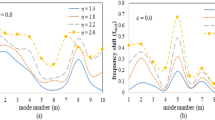Abstract
This paper considers a model of a plastically compressible porous medium with a cylindrical‐type yield condition and its associated constitutive relations, which ensure independent mechanisms of shear and compaction of the porous material. This allows one to use the well‐known theorems of plastic theory to analyze plastically compressible media and obtain analytical solutions for a number of boundary‐value problems, including those taking into account conditions on strong‐discontinuity surfaces. Results from full‐scale studies of the structural periodicity of noncompact materials using wavelet analysis were employed to choose a physical model for a porous body and determine the properties and dimensions of a representative volume. The problem of extrusion of a porous material through a conical matrix was solved.
Similar content being viewed by others
REFERENCES
D. D. Ivlev and G. I. Bykovtsev, Theory of a Strengthening Plastic Body [in Russian], Nauka, Moscow (1971).
Yu. V. Sokolkin and A. A. Tashkinov, Mechanics of Deformation and Fracture of Structurally Inhomogeneous Bodies [in Russian], Nauka, Moscow (1984).
Physical Mesomechanics and Computer Design of Materials [in Russian], Part 1, Nauka, Novosibirsk (1995).
V. V. Zverev, A. G. Zalazinskii, V. I. Novozhenov, and A. P. Polyakov, “Application of wavelet analysis to identification of structurally inhomogeneous deformable materials," J. Appl. Mech. Tech. Phys, 42, No. 2, 363-370 (2001).
A. Freudental and H. Geiringer, The Mathematical Theories of the Inelastic Continuum, Springer Verlag, Berlin-Göttingen Heidelberg (1958).
B. A. Druyanov, Applied Theory of Plasticity of Porous Bodies [in Russian], Mashinostroenie, Moscow (1989).
R. J. Green, “A plasticity theory for porous solids," Int. J. Mech. Sci., 14, No. 4, 215-224 (1972).
A. L. Gurson, “Continuum theory of ductile rupture by void nucleation and growth. Part 1. Yield criteria and flow rules for porous ductile media," Trans. ASME, J. Eng. Math. Tech., No. 1 (1977).
S. P. Kiselev, G. A. Ruev, A. P. Trunev, et al., Shock-Wave Processes in Two-Component and Two-Phase Media [in Russian], Nauka, Novosibirsk (1992).
S. P. Kiselev and V. M. Fomin, “Model of a porous material considering the plastic zone near the pore," J. Appl. Mech. Tekh. Phys., 34, No. 6, 861-869 (1993).
R. I. Nigmatulin, Fundamentals of the Mechanics of Inhomogeneous Media [in Russian], Nauka, Moscow (1978).
A. G. Zalazinskii, Plastic Deformation of Structurally Inhomogeneous Materials [in Russian], Izd. Ural. Otd. Ross. Akad. Nauk, Ekaterinburg (2000).
B. A. Dubrovin, S. P. Novikov, and A. T. Fomenko, Modern Geometry [in Russian], Nauka, Moscow (1979).
A. G. Zalazinskii, “Use of limiting theorems to determine stresses and strains in developed plastic ow of composites," Izv. Akad. Nauk SSSR, Mekh. Tverd. Tela, 6, 106-113 (1984).
S. A. Saltykov, “Stereometric metallography" [in Russian], Metallurgiya, Moscow (1970).
A. A. Burenin, G. I. Bykovtsev, and V. A. Rychkov, “Velocity discontinuity surfaces in an irreversible compressible medium," in: Problems of the Mechanics of Continuous Media [in Russian], Inst. of Automatics and Control Processes, Vladivostok (1996), pp. 116-127.
V. M. Sadovskii, Discontinuous Solutions in Problems of the Dynamics of Elastoplastic Media [in Russian], Nauka, Moscow (1997).
L. I. Sedov, Mechanics of a Continuous Medium [in Russian], Vol. 1, Nauka, Moscow (1976).
C. Truysdell, A First Course of Rational Continuum Mechanics, Johns Hopkins Univ., Baltimore-Maryland (1972).
A. C. Eringen and J. D. Ingram, “A continuum theory of chemically reacting media I" Int. J. Eng. Sci., 2, 197-212 (1965).
A. N. Kraiko, L. G. Miller, and I. A. Shirkovskii, “Gas flows in a porous medium with porosity discontinuity surfaces," J. Appl. Mech. Tekh. Phys., No. 1, 104-110 (1982).
S. P. Kiselev and V. M. Fomin, “Relations at a combined discontinuity in a gas containing solid particles," J. Appl. Mech. Tekh. Phys., 25, No. 2, 269-275 (1984).
I. S. Degtyarev and V. L. Kolmogorov, “Power dissipation and kinetic relations on velocity discontinuity surfaces in compressible rigid-plastic material,” J. Appl. Mech. Tekh. Phys., 13, No. 5, 738-743 (1972).
Yu. N. Rabotnov, Mechanics of a Deformable Solid Body [in Russian], Nauka, Moscow (1989).
Author information
Authors and Affiliations
Rights and permissions
About this article
Cite this article
Zalazinskii, A.G., Polyakov, A.P. Model of a plastically compressible material and its application to the analysis of the compaction of a porous body. Journal of Applied Mechanics and Technical Physics 43, 457–466 (2002). https://doi.org/10.1023/A:1015334907897
Issue Date:
DOI: https://doi.org/10.1023/A:1015334907897




